https://www.972mag.com/israeli-left-nakba-taboo-return/
The past year has seen many left-wing Israeli groups looking beyond the occupation to confront the legacies of 1948, but they remain divided over redressing the exile of Palestinian refugees through return.
By Ben Reiff June 23, 2022
The depopulated Palestinian village of Mi’ar lies some 17 kilometers east of Acre in the north of Israel. It doesn’t appear on modern maps, and there are no road signs to direct you to all that remains of the village today: two cemeteries, the larger one surrounded by the prickly pears that once marked the village’s border. Everything else — from the local school to the homes of the hundreds of people who lived here prior to July 1948 — has been totally erased from the landscape and from the consciousness of the Israeli public.
The village wasn’t destroyed during the war itself; that occurred over the course of the two subsequent decades, as its Palestinian residents, who had fled in fear of the advancing Zionist forces, attempted several times to return to their homes. Many of those residents were internally displaced, remaining inside the borders of the new state and receiving Israeli citizenship, yet were marked as “present absentees” with no rights to their own property.
Mi’ar is just one of an estimated 600 Palestinian localities that were totally depopulated of their residents during the Nakba (“catastrophe”) of 1948, when more than 700,000 Palestinians fled or were expelled from their land in what became the State of Israel — and have been forbidden from returning ever since. This year, Mi’ar was chosen by the Committee for the Defense of the Rights of the Internally Displaced Persons in Israel, which advocates for these refugees’ right to return to their ancestral land, as the location for the 25th March of Return, which takes place each year on Israel’s Independence Day.
Among the thousands who joined this year’s march from all over the country were activists from Zochrot (Hebrew for “remembering”), which describes itself as “the only organization that focuses on recognition of the Nakba and support for return in Israeli society.” Along with organizing a historical-political tour of the village before the march took place, Zochrot had its own stall at the end of the march offering informational booklets in Hebrew about other depopulated Palestinian villages.
When Zochrot was established two decades ago, talking about the Nakba within Jewish-Israeli society was a very lonely endeavor. Today, while it is still the only Israeli organization of its kind, the conversation on the Israeli left has changed significantly. Over the past few years, and especially since the events of May 2021 — which saw an escalation in violence not only in the occupied West Bank and besieged Gaza Strip but also within Israel’s binational cities — left-wing groups that traditionally dealt exclusively with the post-1967 occupation have increasingly begun reckoning with the Nakba. 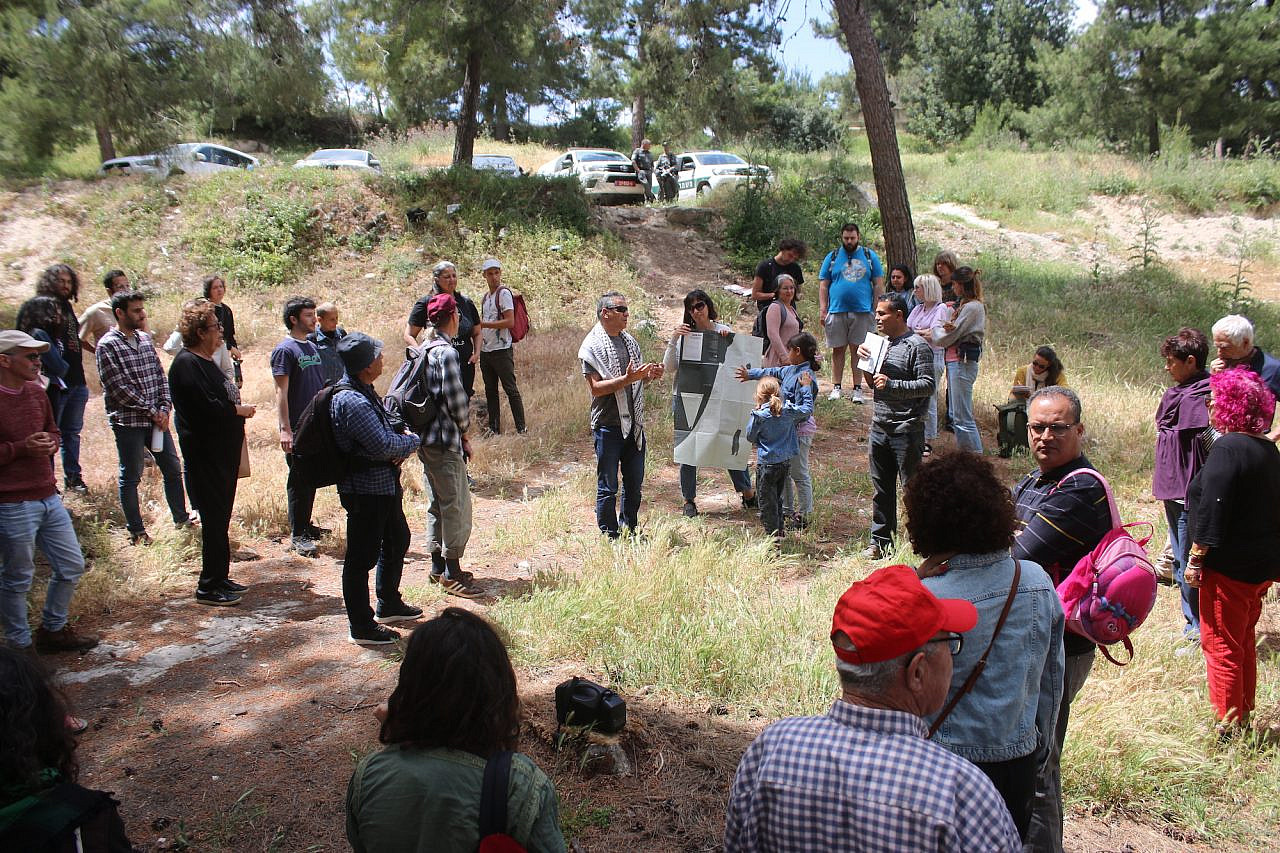
Zochrot’s Umar al-Ghubari leads a tour in the depopulated Palestinian village of Mi’ar, ahead of the 25th annual March of Return, May 5, 2022. Mi’ar’s residents fled during the Nakba in fear of the advancing Zionist forces, and Israel destroyed their houses over the following two decades. (Ahmad Al-Bazz)
+972 Magazine spoke to activists in several of these organizations about the shifts they are undergoing. From these conversations, it is clear that the Nakba is no longer the taboo it once was in Israeli society, and that this change is being driven in large part by Palestinian citizens of Israel, who are pushing Jewish activists within their organizations and beyond to confront the realities of 1948.
However, while recognition of Israel’s responsibility for the Palestinian refugee problem is certainly on the rise among the Israeli left, far fewer support redressing it by recognizing the right of those refugees to return. As a result, some activists fear that what appears on the surface to be a positive development could in fact be serving to disconnect the notion of responsibility from redress.
‘Most Israelis today know what the Nakba is’
Since its establishment in 2002, Zochrot has dedicated its energies to raising awareness about the Nakba in Israel by leading tours to depopulated villages and gathering testimonies from internally displaced Palestinian families. “When Zochrot started 20 years ago, there was a void,” Zochrot’s Executive Director Rachel Beitarie tells +972. “Most Israelis didn’t know what the Nakba was and hadn’t even heard the term.”
While older generations of Israelis remembered seeing the depopulated villages, and possibly even witnessed the expulsions, that history was “deeply denied,” Beitarie continues. Her generation, she says, “grew up with the remains of these villages literally under our feet without ever knowing what they were — or at least there was a state of knowing and not knowing at the same time.” 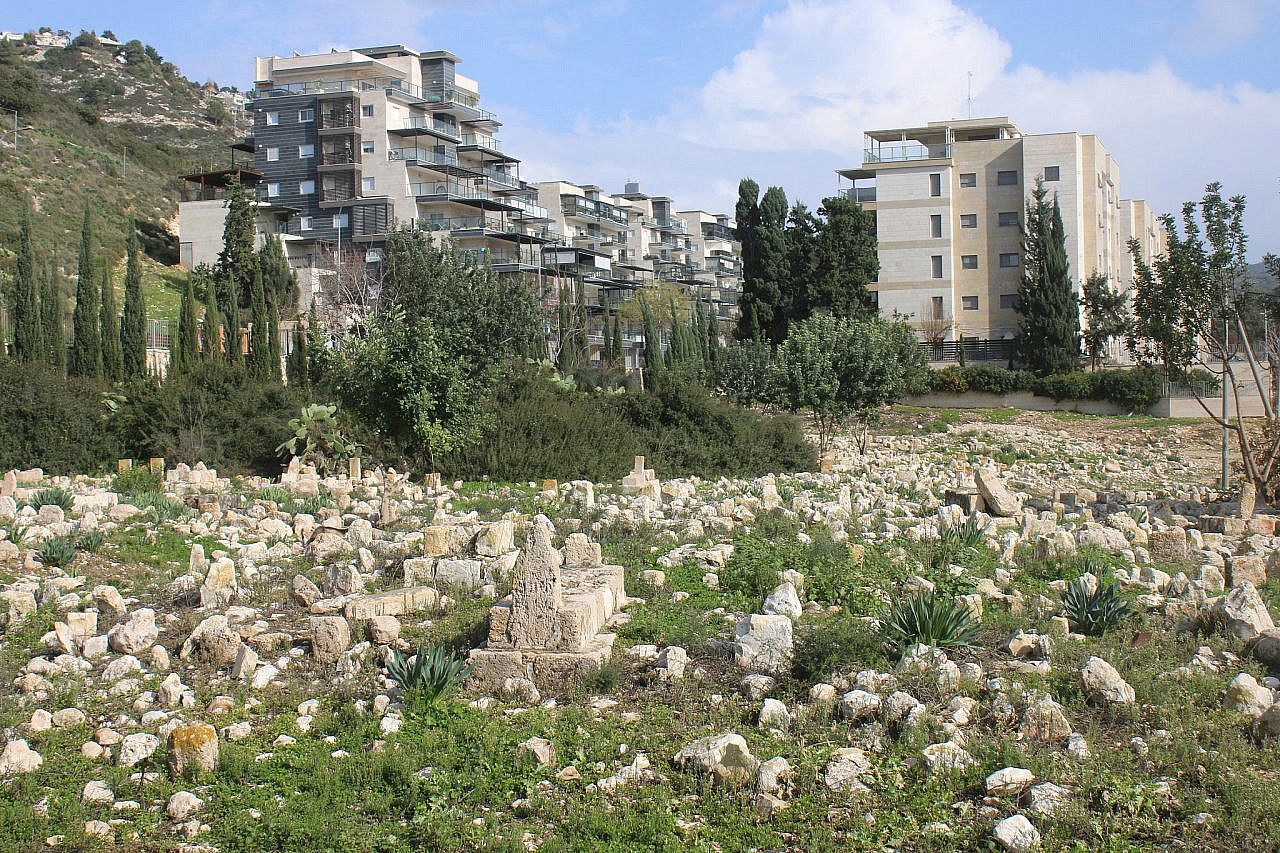
The buildings of Tirat HaCarmel overlook the graveyard of the depopulated Palestinian village of al-Tira, south of Haifa. (Ahmad Al-Bazz)
Umar al-Ghubari, a Palestinian citizen who guides Zochrot’s tours, explains the parallel but opposite process which led many Palestinians in Israel to also know little about the 1948 war until more recently. “The Palestinians had many years of silence around the Nakba,” he says. “They were afraid to talk about it because of the trauma and the shame, and they were terrorized by the atmosphere in Israel, where they lived under a military regime until 1966.” According to al-Ghubari, this silence continued with the second generation of Palestinians who inherited those same fears.
It was not until some five decades later, when many of the first generation of refugees were reaching the end of their lives and a third generation was coming of age, that Palestinian citizens of Israel began talking more openly about the Nakba. The first March of Return to a displaced village, for example, was organized in 1998, exactly 50 years after the war. “This was also a reaction to the Oslo agreement, in which the PLO didn’t mention the Palestinians in Israel as part of the Palestinian people,” adds al-Ghubari. “Around that time, I started hearing the term ‘Nakba’ more and more in Arabic.”
It was around this time, too, that the activists who formed Zochrot began organizing under the name “Nakba in Hebrew,” bluntly reflecting what would become the organization’s primary goal: to integrate the word into the Hebrew language. “I think in large part it happened: most Israelis today know what the Nakba is,” says Beitarie. “Whether they agree it was a crime or not is another question.”
Ironically, the fact that so many Israelis do know the term today is partly thanks to attempts by the Israeli right to suppress discussion of the Nakba entirely — which have clearly backfired. Successive efforts at censorship — from the Education Ministry banning the use of the term in school textbooks in 2009; to the enactment of the 2011 “Nakba Law,” which threatens to cut the budgets of any public body that commemorates Israel’s Independence Day as a “national day of mourning”; to the decade-long “Nakba bullshit” campaign by the far-right group Im Tirtzu — have only increased awareness among Jewish Israelis. Nowadays, after those efforts failed, prominent leaders on the Israeli right are more likely to threaten Palestinians with another Nakba. 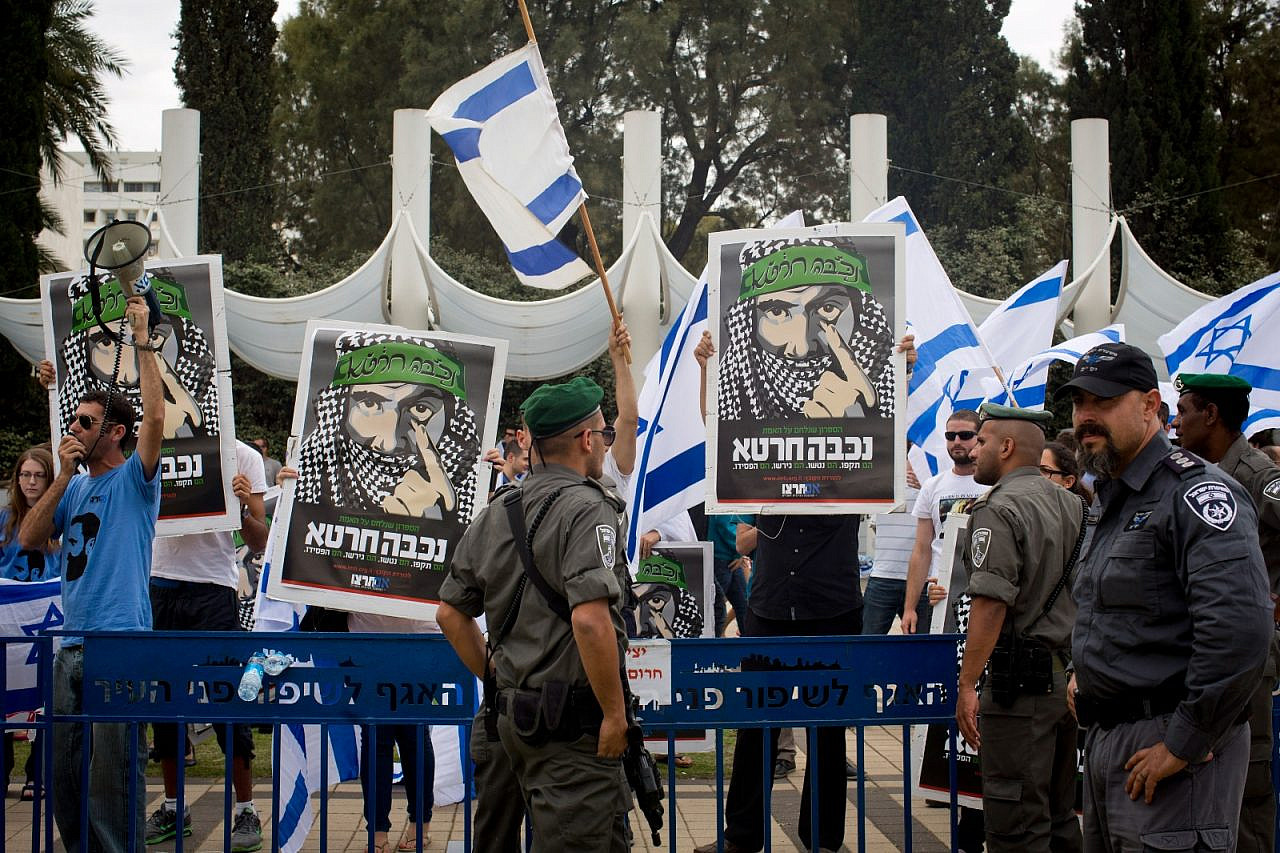
Activists from the far-right Im Tirtzu movement hold up “Nakba bullshit” posters at a demonstration next to the Nakba Day commemoration event held by Palestinian students at Tel Aviv University, May 15, 2022. (Oren Ziv/Activestills)
Over the past few years, however, Zochrot has begun talking more explicitly about what redress and justice would look like at the political level. Encapsulating this shift, the organization’s “iNakba” app, which provides users with an interactive map showing the locations of every depopulated Palestinian village, will soon be relaunched under a new name: “iReturn.”
“Zochrot has always recognized the right of return,” says Beitarie, “but we moved sometime during the last decade toward trying to imagine how return can be implemented practically.” To that end, Zochrot has collaborated with Palestinian organizations in Bethlehem, Haifa, and Nazareth to conduct workshops with Palestinian youth, thinking together about what return would look like in a reality in which most former Palestinian homes have either been destroyed or are now inhabited by Jewish Israelis.
For Zochrot, then, it is clear that the Nakba is not merely a tragic historical event that needs to be remembered, but rather an ongoing injustice that can only be rectified through decolonization — precisely as many Palestinians have long advocated. Such a vision for the future is not something Jews need to fear, says al-Ghubari: “We don’t believe that Palestinian return will, or should, require expelling the Jewish community that already lives here, but rather changing the political system that maintains power for one side over the other.”
‘If we want real peace, we need to go back to the real problem’
In recent years, there has undoubtedly been a parallel shift toward recognition of the Nakba among other Israeli left-wing groups. But in contrast to Zochrot, most of these groups remain far away from advocating explicitly for the right of return.
One of the primary arenas in which this trend is playing out is inside joint Jewish-Palestinian organizations, driven by an empowered generation of Palestinian citizens of Israel willing to speak without reservation about the injustices that befell their families and the need to confront the legacies of 1948, not just 1967.
One such organization is Combatants for Peace, made up of Israelis and Palestinians who actively participated in armed conflict either as soldiers or resistance fighters. For most of its existence, the organization’s modus operandi has been to pair groups of Israeli Jews with groups of Palestinians from the West Bank in order to participate in joint, nonviolent direct actions against the occupation. This has begun to change in recent years, however, with the creation of a “northern group” made up of Jewish and Palestinian citizens of Israel. 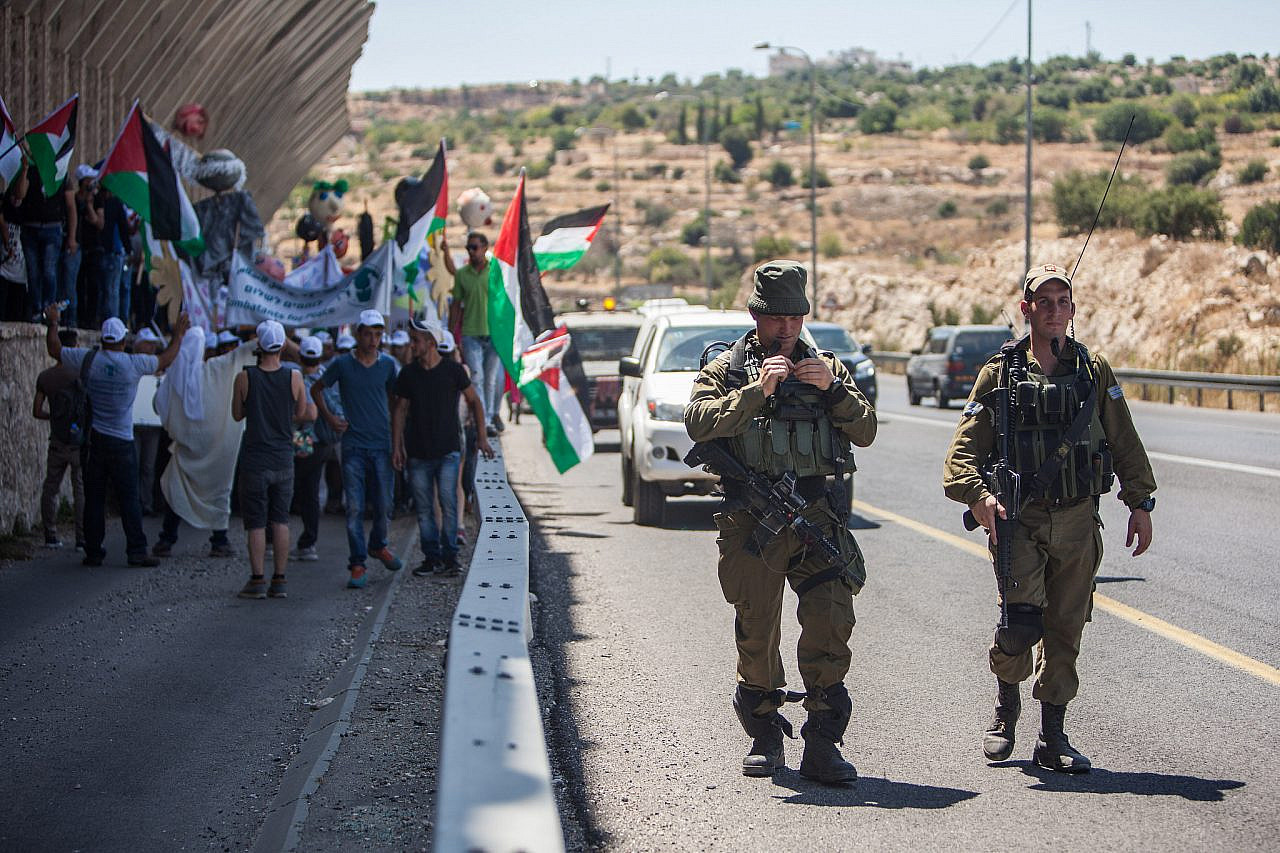
Palestinian and Israeli activists from Combatants for Peace protest against the occupation, under the watch of Israeli soldiers, alongside the separation barrier on Route 60 near Bethlehem, occupied West Bank, July 15, 2016. (Zack Wajsgas/Flash90)
“When I joined Combatants for Peace, our partners were Palestinians from the West Bank,” explains Itamar Feigenbaum, a Jewish-Israeli activist who was among those behind the new initiative. “Many of them are second- or third-generation refugees. As I got to know them better and heard their stories, I slowly realized how central the issue of the Nakba is.” Feigenbaum then began meeting with a small group of activists in the north of Israel, where the idea to create a sub-group within Combatants for Peace crystallized.
It wasn’t long before they decided what the focus of their activities would be. “A couple of friends who were part of the initial conversations were from families expelled from Mujaydil, a village near Nazareth where Migdal HaEmek now stands,” Feigenbaum recalls. “The depopulated village of Ma’alul is also nearby. So from there grew the idea of leading tours to these villages.”
The initiative became known as Project 531, a reference to one conservative estimate of the number of depopulated Palestinian villages inside Israel. “I thought we would have to explain to people why it’s logical for the organization to do this, but I was surprised: most of the activists immediately understood,” Feigenbaum adds.
For Halima Ibrahim, one of the Palestinian activists in the northern sub-group, this is the first joint initiative in which she’s participated that deals directly with the Nakba. “It really affected me to see Jews joining us on these tours,” she tells +972. “It’s good for them to learn about what was here before — that these villages were full of life, and now there is nothing. It’s not easy for them, but I see that they understand: if we want real peace, we need to go back to the real problem.” 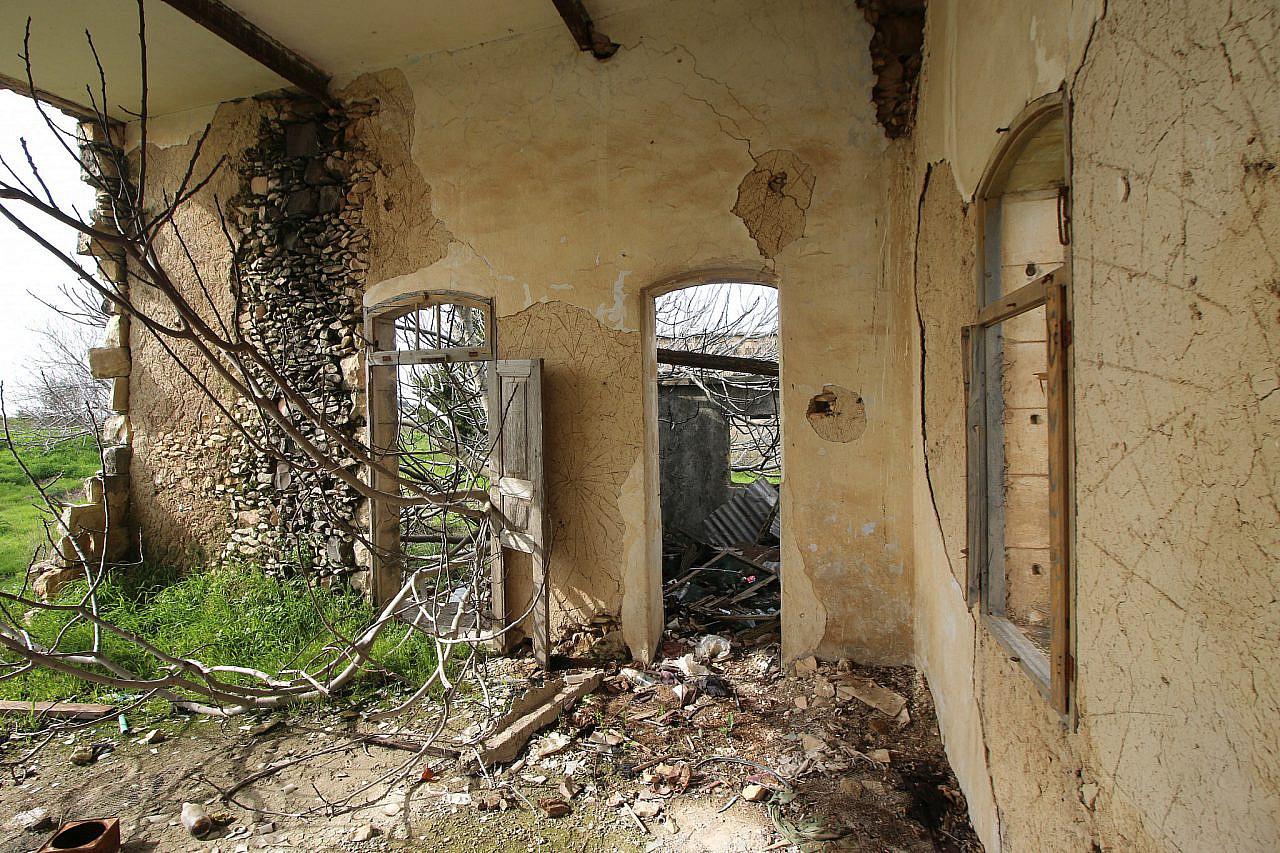
The remains of a house in the depopulated Palestinian village of Deir al-Qasi in the Upper Galilee. (Ahmad Al-Bazz)
Another development in this direction has been Combatants’ creation of a Joint Israeli-Palestinian Nakba Remembrance Ceremony, which has taken place in each of the past three years. Activists share stories of Palestinian exile and dispossession in both Arabic and Hebrew, connecting those histories to Israel’s ongoing efforts to displace Palestinian communities on both sides of the Green Line today.
“If I remember correctly,” says Feigenbaum, “the idea for this ceremony came from our Palestinian partners, and it made sense to all of us. I guess we all underwent the same process of understanding that we have to educate ourselves and make space for [talking about] 1948, because this is part of the conflict — it’s not just about ‘the occupation.’”
Legacies of May 2021
Unlike Combatants for Peace, the grassroots movement Standing Together, founded in 2015, only organizes Israeli citizens, Jews and Palestinians alike. It aspires to break down the traditional divisions in Israeli society and build the base for a new left with the power to achieve victories across a range of progressive struggles, including ending the occupation.
As a result, the group’s elected leaders find themselves having to constantly navigate the tensions between their own internal political discourse and the messaging that they believe will best advance their collective strategy. “We’re trying to build a movement that has a very radical, leftist core, but is also trying to mobilize a base which is all over the spectrum,” explains Sally Abed, a Palestinian activist in Standing Together’s national leadership. 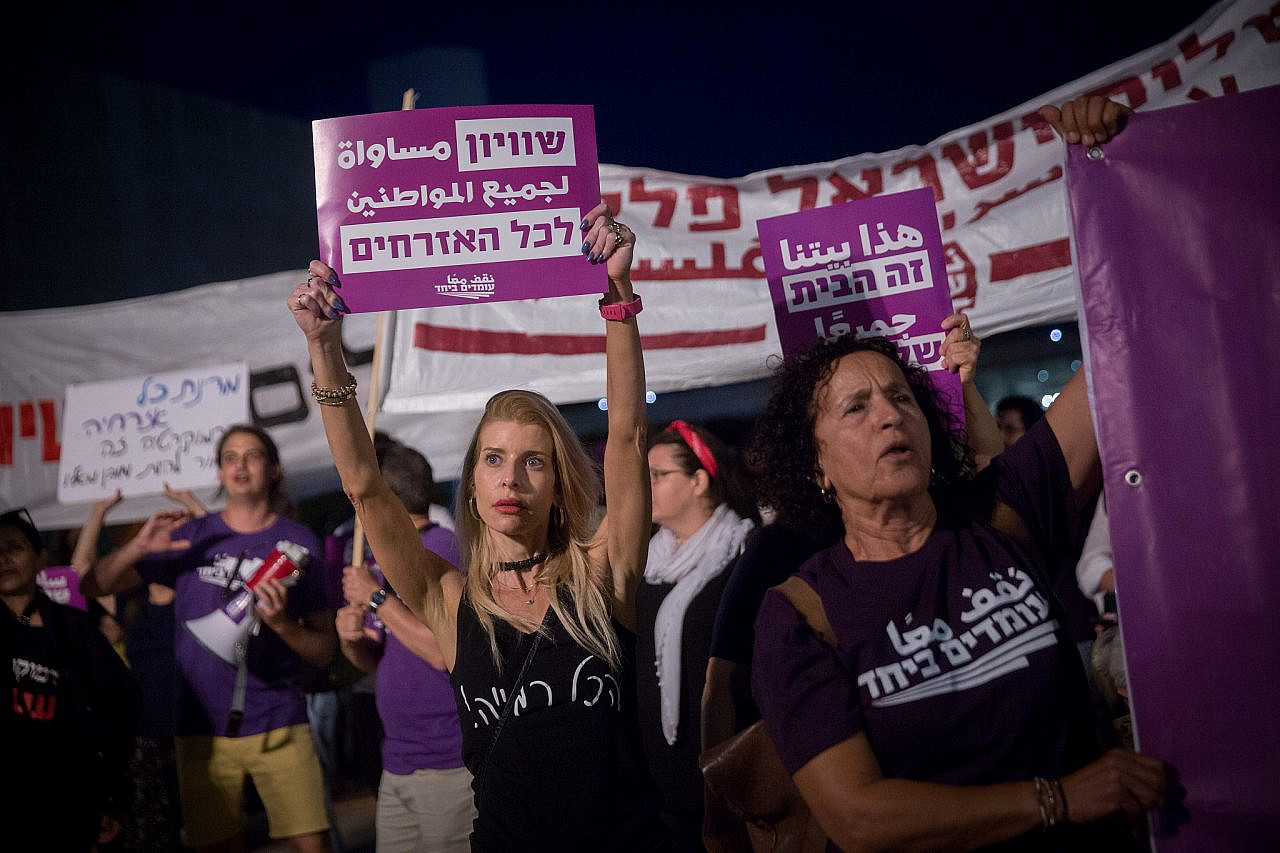
Activists from the Standing Together movement hold up signs in support of peace and equality at a demonstration in HaBima Square, Tel Aviv, May 22, 2021. (Miriam Alster/Flash90)
Naturally, given the unpopularity within Israeli society of acknowledging responsibility for the refugee problem, the Nakba presents one such point of tension. “In internal conversations, the issue of the Nakba is obvious,” says Abed. “We know that ending the occupation alone is not going to achieve a just peace. But when we talk about the Nakba, which is an important and necessary step, we’re always conscious of how it affects our strategy: we don’t just want to be right, we want to win.”
Still, Abed notes a shift in recent years within the movement’s base — most evident during the events of May last year — which is causing the leadership to engage more with the roots of inequality in Israeli society.
“It’s not necessarily as explicit as saying ‘we want to talk about the Nakba and the right of return,’ but rather an insistence by Palestinians, and many Jews too, on the narrative that connects the systematic discrimination of Palestinians inside Israel with the Palestinians under occupation — which, ultimately, connects everything back to 1948. This definitely affected our discourse last May,” she explains.
The events of that month made those connections abundantly clear. While Palestinians in the Jerusalem neighborhood of Sheikh Jarrah rose up against Israel’s attempts to evict them in favor of Jewish settlers, Palestinians in Israel’s so-called “mixed cities” were being terrorized by settlers and police alike, all while Palestinians in Gaza were living through another aerial bombardment by Israel’s airforce, from which they had no escape.
What became known as the “Unity Intifada,” which included a general strike observed across all of historic Palestine, reinforced the message that the physical fragmentation of Palestinians cannot hide the fact that they are one people. 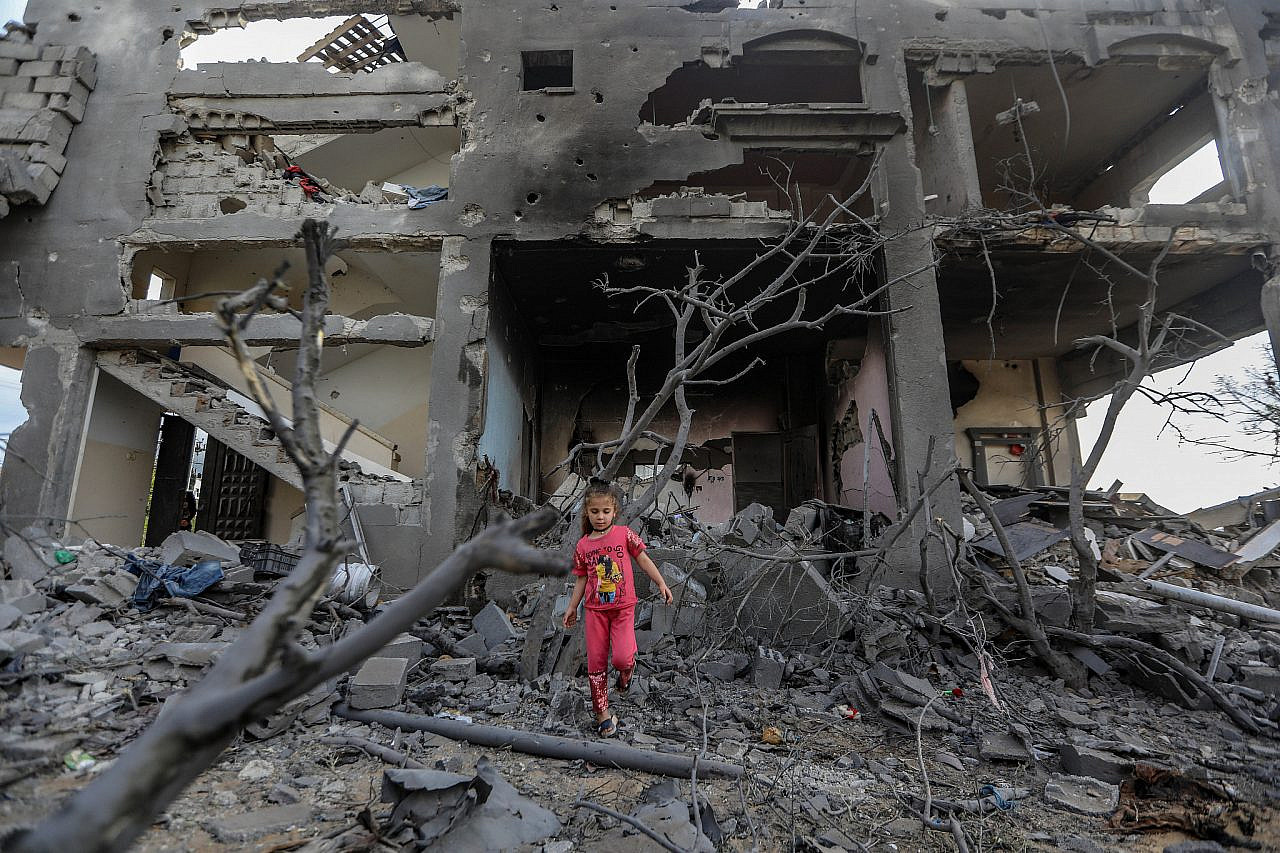
A Palestinian child stands amidst the ruins of a building in the aftermath of Israeli airstrikes, Beit Hanoun, Gaza Strip, May 21, 2021. (Mohammed Zaanoun)
The impacts of May 2021 appear to be filtering through to other joint Jewish-Palestinian organizations, too. In late April, Sikkuy-Aufoq, a liberal NGO advancing Jewish-Arab equality in Israel that was founded more than three decades ago, published a Facebook post on Israel’s Independence Day that caught many by surprise for its blunt acknowledgment of the need to redress the Nakba, including the return of refugees.
“Since 1948,” the post reads, “no effort has been made to redress the injustice, not at the level of a comprehensive and just solution, nor even at the level of recognition of the right of the displaced to return — even to land that remains open and empty.” It goes on: “Recognition of the Nakba and readiness to redress the injustice is in the clear interest of all who live here — Jews and Arabs alike.”
The statement’s bold language, which went far beyond the discourse that most observers have come to expect from the organization, could point to the direction of travel for similar organizations in the months and years to come.
The view from the Zionist left
Peace Now is perhaps the organization that most strongly symbolizes the Israeli left’s traditional refusal to look beyond the 1967 occupation as the root of the conflict. During its first decade, in the 1980s, Peace Now was arguably the main force within Israeli society pushing for an end to the occupation and for peace negotiations with the Palestinians. More than 20 years since the collapse of the Oslo process, however, the movement remains wedded to this vision of a two-state solution — unlike the other groups mentioned in this article, which generally opt for a greater degree of agnosticism when it comes to political solutions.
Peace Now’s interim Executive Director Dana Mills tells +972 that despite the two-state solution still forming the bedrock of its advocacy, the organization is nonetheless undergoing significant changes of its own — especially since last May. “The Peace Now of today is not the Peace Now of my youth,” explains Mills, who first joined the movement in 1995. “There was definitely no understanding of the Nakba then; it was all about 1967.” 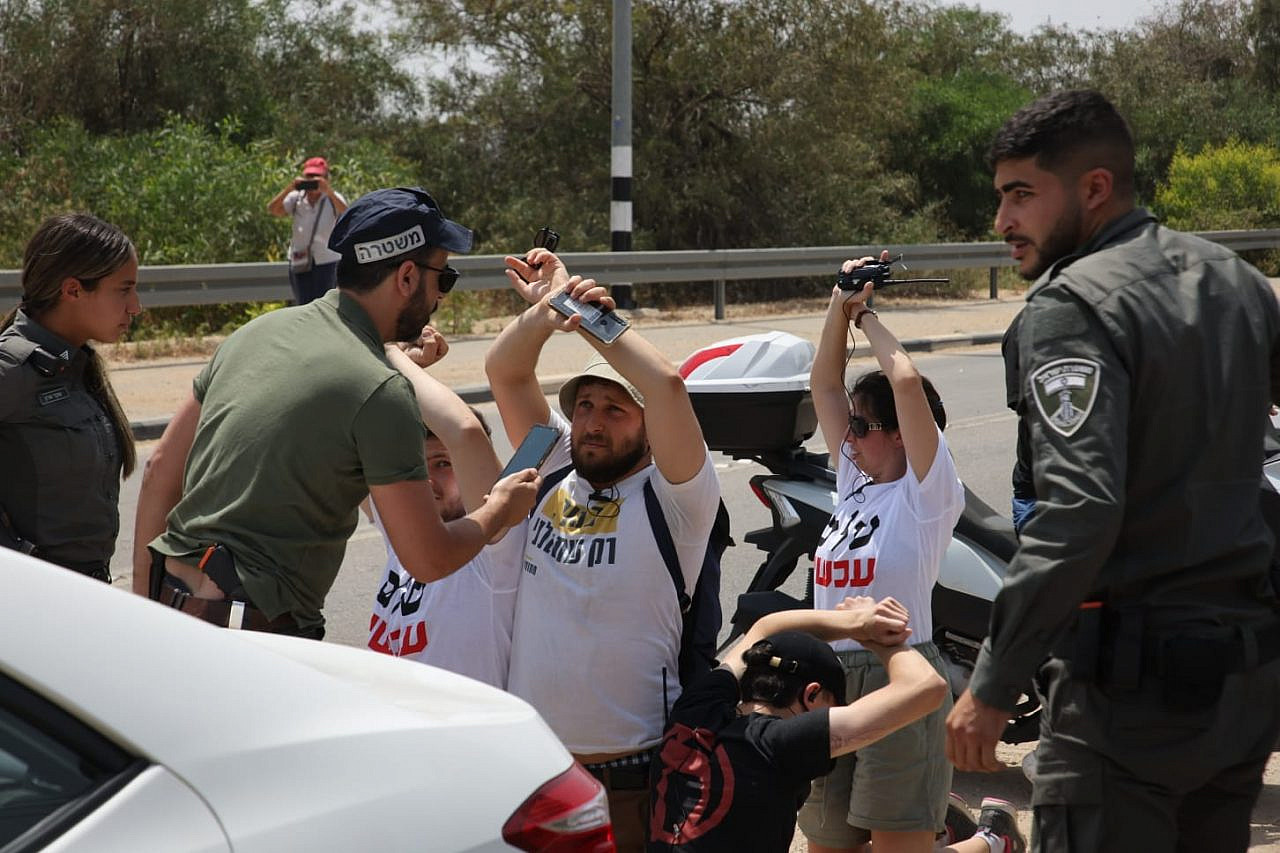
Activists from Peace Now and other left-wing Israeli groups block a road to try to prevent a police detention at a demonstration against the Homesh settler outpost, Rosh Ha’ayin, May 28, 2022. (Oren Ziv)
She continues: “I think culturally there’s a shift [within Israeli society] toward better understanding the history of the Palestinian people, and the weight of what they come to the table with. Focusing on the 1967 borders as the goal for a solution doesn’t mean that we shouldn’t talk about justice more broadly within the arena in which we’re working.”
On a personal level, too, Mills explains how she has undergone her own process of reckoning with the Nakba. The release of the documentary film “Tantura” earlier this year was particularly influential, in which Israeli soldiers who fought in the 1948 war admit to massacring dozens of Palestinians in the now-depopulated coastal village in northern Israel after it had already been conquered, and burying them in a mass grave. The massacre, which has only recently broken into the Israeli public consciousness, has long been known and documented in Palestinian memory of the Nakba through oral testimonies, historiography, and literature.
“That film for me was a breaking moment,” Mills says. “I’m from Zichron Ya’akov [a town in northern Israel, located 10 kilometers from where the massacre took place], and Tantura was the beach where I learned to swim. Now I know that there’s a mass grave under my most picturesque childhood memory.”
Mills also acknowledges the “tremendous work by non-Zionist movements to the left of us that really pushes us to think more about these things,” adding that having groups with diverse political stances enriches the overall struggle for peace and justice. “Everyone in the coalition has their role. We can affect someone who might not want to go on a tour with Zochrot, but if Peace Now talks about the ‘second displacement’ when explaining the threat of eviction facing Palestinians in [the East Jerusalem neighborhoods of] Sheikh Jarrah and Silwan, then something resonates.”
The group’s recognition of the injustices that took place in 1948, however, doesn’t entail a recognition of the right of return for Palestinian refugees. “As a Zionist organization, we don’t advocate the right of return,” says Mills. “But we do think that we will have to address it at some point at the discussion table, and within the context of any political solution.” 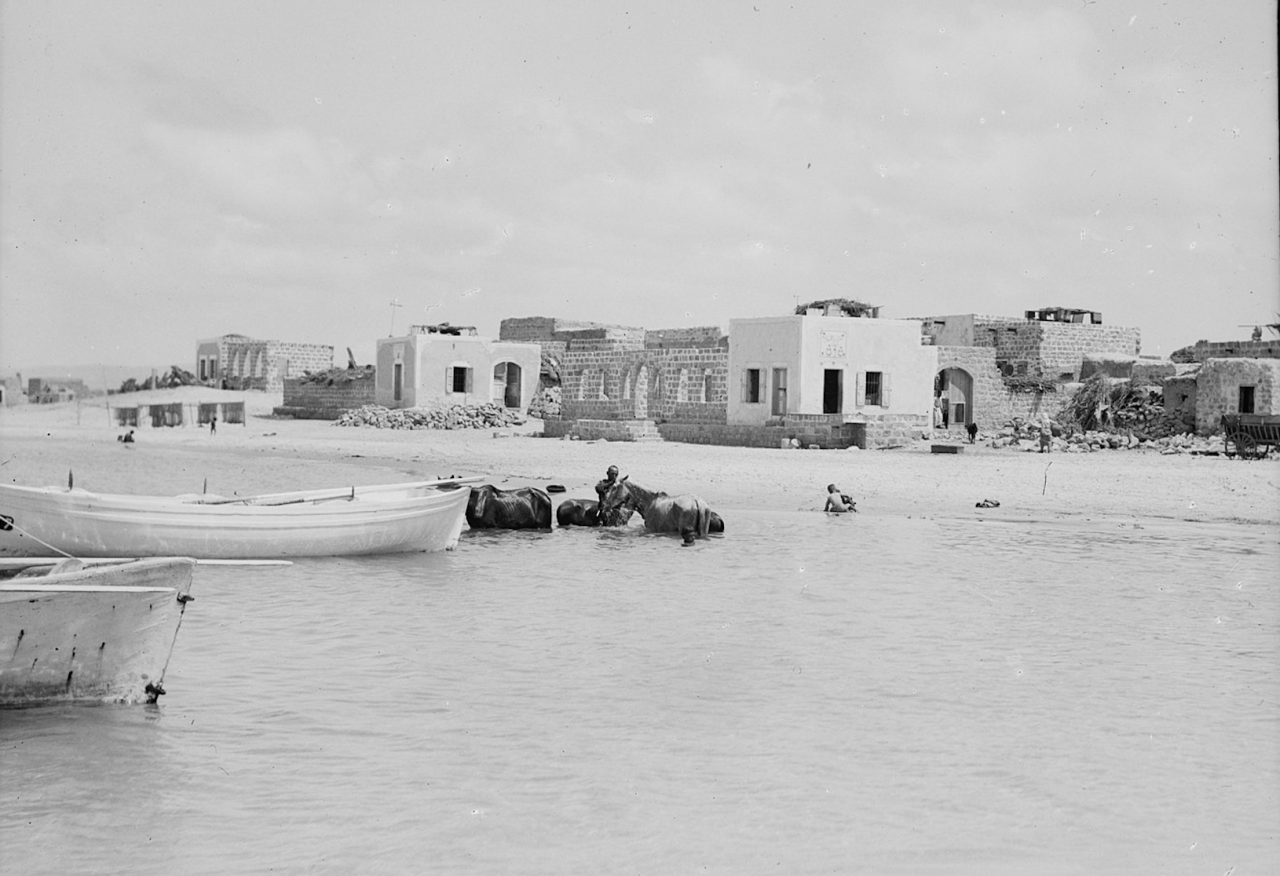
The Palestinian coastal village of Tantura photographed sometime between 1920 and 1933, prior to the village’s destruction. (Matson Collection)
The same is true for Breaking the Silence which, despite not being explicitly Zionist like Peace Now, focuses its efforts on ending the 1967 occupation — specifically by collecting and publicizing testimonies from former Israeli soldiers who served in the occupied territories. The organization’s advocacy director, Ori Givati, tells +972 that there is an important reason for the specificity of their work, but that it doesn’t mean they ignore the Nakba.
“If you come on a tour with us, you’ll see that the historical analysis will never start from 1967, or even 1948,” he says. “But it’s really important to understand that there is a difference between ‘48 and ‘67 [i.e. the two sides of the Green Line]. In the occupied territories, there is a military dictatorship where the army is the authority. The level of violence, discrimination, and apartheid are on a different level from what you see in ‘48, although very intertwined.
“Every single morning,” Givati continues, “we wake up and choose to continue occupying the Palestinian people, and that’s such an important element of the conflict.” The organization’s “added value,” he explains, comes from gathering soldiers’ testimonies to shed light on the reality on the ground from those who actively perpetuated it.
At the same time, Givati notes that the group’s thinking is not static, and is being pushed by ties to Palestinian organizations on both sides of the Green Line which predate, but have been expedited by, the events of May 2021. “We’re investing a lot of time and effort to educate ourselves about the Nakba and about the military regime over the Palestinian people inside the Green Line until 1966,” he says. “So this is an ongoing process.” 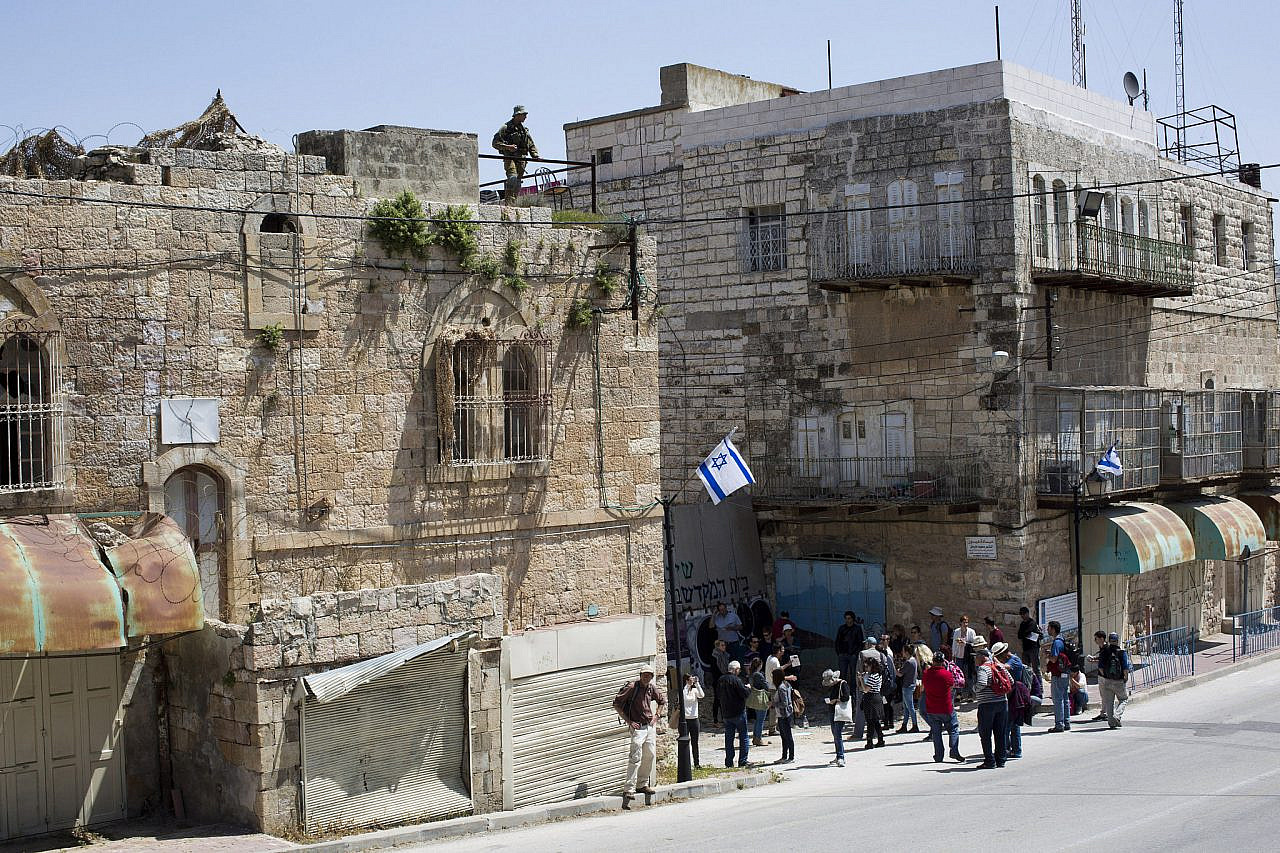
Israelis stand on Shuhada Street in the Old City of Hebron, occupied West Bank, as part of a tour organized by Breaking the Silence, April 4, 2014. Palestinian access to Shuhada Street is almost entirely restricted by the Israeli army, whereas Israeli settlers can use it freely under the army’s protection. (Activestills)
A fork in the road
Further examples of these recent shifts in the Israeli left’s relationship toward the Nakba abound. In an op-ed published in May 2021, Aluf Benn, the editor-in-chief of the liberal Haaretz newspaper, argued that Israeli Jews “must talk about the Nakba, not only in Palestinian memorial processions to the villages of their fathers and mothers, in small conferences held by Zochrot and in history books by opposition historians, but in prime time… in high school classes and in university lecture halls.” But despite mentioning “their [i.e. Palestinians’] hope to implement a right of return,” Benn stopped short of including this within his own prescriptions.
More recently, B’Tselem director Hagai El-Ad signaled in an op-ed of his own in Haaretz that his organization — which last year became the first Israeli human rights NGO to label Israel an apartheid regime between the river and the sea — might be pivoting toward a political analysis that centers 1948. Referring to the Israeli High Court’s decision to authorize the expulsion of over 1,000 Palestinian residents from the Masafer Yatta region of the South Hebron Hills, El-Ad described the move as “another phase of the Palestinian Nakba, with Israeli court approval.”
Among the groups that posted about the Nakba on social media on Israel’s Independence Day this year were Call.Activit, a new cultural collective that provides a home for Israel’s Black queer community. “Who knows like we do the sophisticated mechanisms the system uses to oppress,” they wrote, referring to the structural racism experienced by Ethiopian Jewish immigrants in Israel over the past several decades. “We should be the first to question the narrative that the system tells us about Palestinians.”
A notable example of more explicit support for the right of return came in the form of last year’s “Shiministiyot Letter,” in which 60 Israeli high school seniors declared their refusal to serve in the military — a decision which could land them in jail. While such letters are not uncommon, this was the first to mention the Nakba as a central reason for refusing to serve.
“The actions of the Israeli military [today],” they wrote, “are nothing but a continuation and upholding of the legacy of massacre, expulsion of families, and land theft, the legacy which ‘enabled’ the establishment of the State of Israel as a proper democratic state for Jews only. Justice requires reform in the form of the end of the occupation, the end of the siege on Gaza, and recognition of the right of return for Palestinian refugees.” 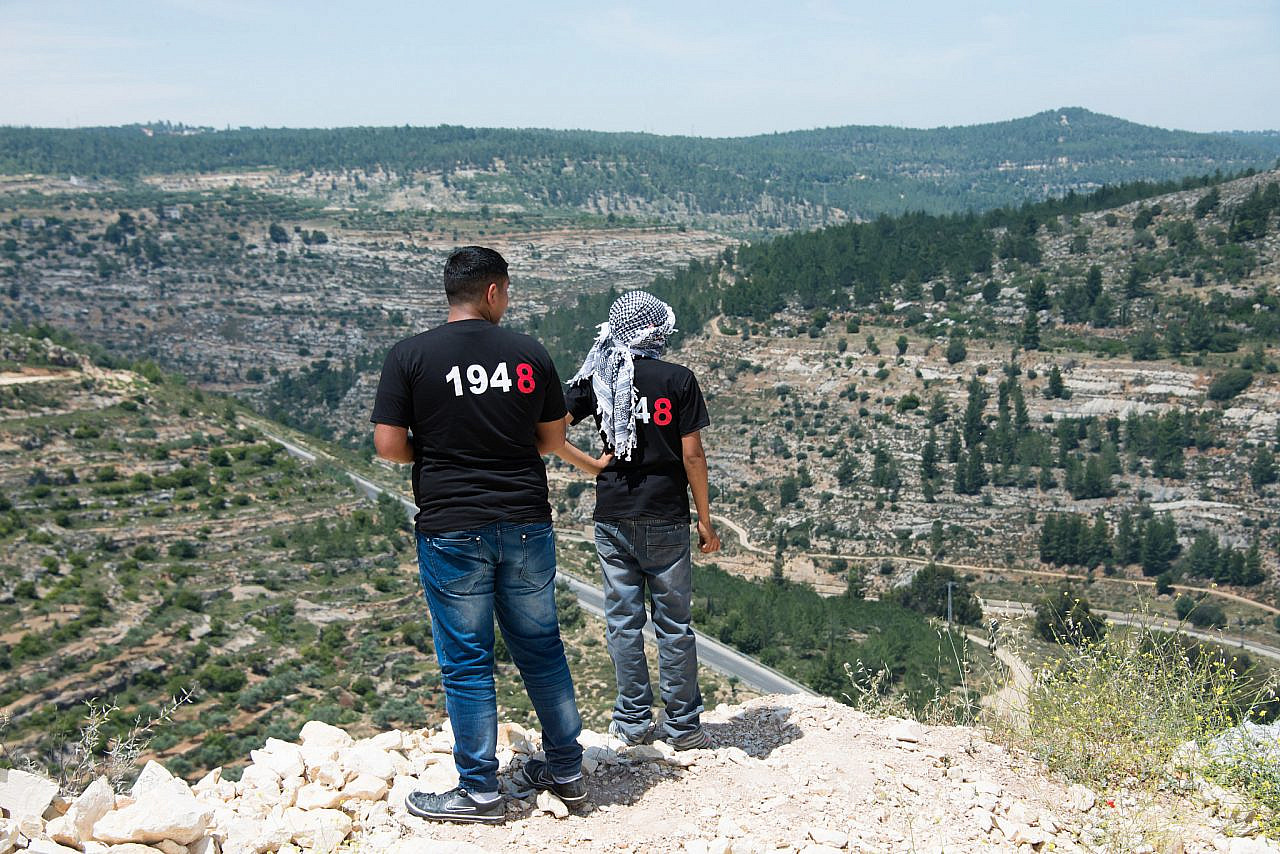
Palestinian youth look over a valley at a road used by settlers to enter Jerusalem, during a Nakba Day protest in the occupied West Bank village of Al-Walaja, May 15, 2014. (Ryan Rodrick Beiler/Activestills)
Reflecting on these developments, Zochrot’s Beitarie welcomes the growing recognition of the Nakba across much of the left in Israel, but argues that simply recognizing the historical facts is not enough. “I see a lot of important steps in many of these organizations, and a lot more willingness to acknowledge the facts, but much less willingness to acknowledge responsibility and consider what it means for a future solution,” she says.
“In the past year or two,” Beitarie continues, “I’ve seen a worrying attempt to bypass all the difficult questions and go straight to the era of reconciliation. I see it in suggestions that we need to put the Nakba in our textbooks and maybe put up some memorials, but without there needing to be any practical repercussions. There is little recognition of the right of return, which is of course an internationally recognized right, but it’s a non-starter for most Israelis, even on the left.”
Beitarie’s colleague al-Ghubari is similarly pensive about what these developments signify going forward. “We want to be in contact with these organizations and to open their eyes and influence their speech, even if they’re dealing with the issue of the occupation in the West Bank or Gaza. Fortunately, in the last year, more and more organizations in this field started mentioning the Nakba as the crucial starting-point — they can’t avoid it. But their position regarding return is more complicated.”
The enduring reluctance, even on the Israeli left, to entertain the notion of Palestinian refugees returning to their lands is easy enough to explain: whereas simply acknowledging the injustices perpetrated in 1948 does not necessarily threaten the privileges guaranteed to Israeli Jews by even the most liberal conceptions of Zionism, the return of refugees would mean relinquishing them. It remains to be seen which of these two positions the majority of the Israeli left — from the grassroots to the Knesset — will adopt, and it is not a choice they can avoid making as recognition of the Nakba continues to grow.
“We’re in a very deep political crisis that has been building up for more than 20 years, since the collapse of Oslo,” says Beitarie. “There is a search for answers and solutions, part of which means looking at the roots of the so-called conflict. And once you start looking for answers, the Nakba is everywhere.”
No comments:
Post a Comment